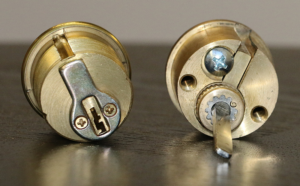Mortise lock cylinder are an essential component of many door locking mechanisms. They play a critical role in ensuring the security and safety of your home or office. In this article, we will provide an overview of what mortise lock cylinders are, how they work, and some tips on installation and maintenance.
What is a Mortise Lock Cylinder?
A mortise lock cylinder is a type of locking mechanism that is commonly used in doors. It is a cylindrical metal component that fits inside the mortise, a cavity or pocket that is cut into the door. The cylinder is usually operated by a key, which engages with pins inside the cylinder to unlock or lock the door.

How Does a Mortise Lock Cylinder Work?
Mortise lock cylinders work by using a series of pins that are pushed up and down by the key. The pins are set to specific heights, and when the key is inserted into the cylinder, it pushes the pins up to their correct height, which allows the lock to turn and the door to be unlocked. When the key is removed, the pins fall back down into the cylinder, and the lock is engaged again.
Installation of a Mortise Lock Cylinder
Installing a mortise lock cylinder can be a complex process, but it is crucial to ensure that it is done correctly to maintain the security and safety of your property. Before beginning the installation process, make sure that you have all the necessary tools and materials.
Step 1: Remove the old lock cylinder
If you are replacing an old lock cylinder, start by removing it from the door. This may require unscrewing or prying off a cover plate.
Step 2: Install the new lock cylinder
Insert the new mortise lock cylinder into the mortise on the door. Make sure that the cylinder is properly aligned and that the screws are tightened securely.
Step 3: Test the lock
Once the lock cylinder is installed, test it to make sure that it is working correctly. Insert the key and turn it to ensure that the lock is engaging and disengaging smoothly.
Maintenance of a Mortise Lock Cylinder
Regular maintenance of a mortise lock cylinder is essential to ensure that it continues to function correctly and to extend its lifespan. Here are some tips for maintaining your lock cylinder:
- Keep it clean: Dirt and debris can build up inside the cylinder, which can cause it to malfunction. Clean the cylinder regularly with a soft brush or compressed air.
- Lubricate the cylinder: Use a silicone-based lubricant to keep the lock cylinder functioning smoothly. Avoid using oil-based lubricants, as they can attract dust and debris.
- Check for wear and tear: Over time, the pins and other components of the lock cylinder can wear down. Check the lock regularly for signs of wear and replace any damaged or worn components.
Mortise lock cylinders are an essential component of many door locking mechanisms. They play a crucial role in ensuring the security and safety of your home or office. By understanding how they work, following proper installation procedures, and regularly maintaining them, you can ensure that your lock cylinders will continue to function correctly and provide you with the security you need.
